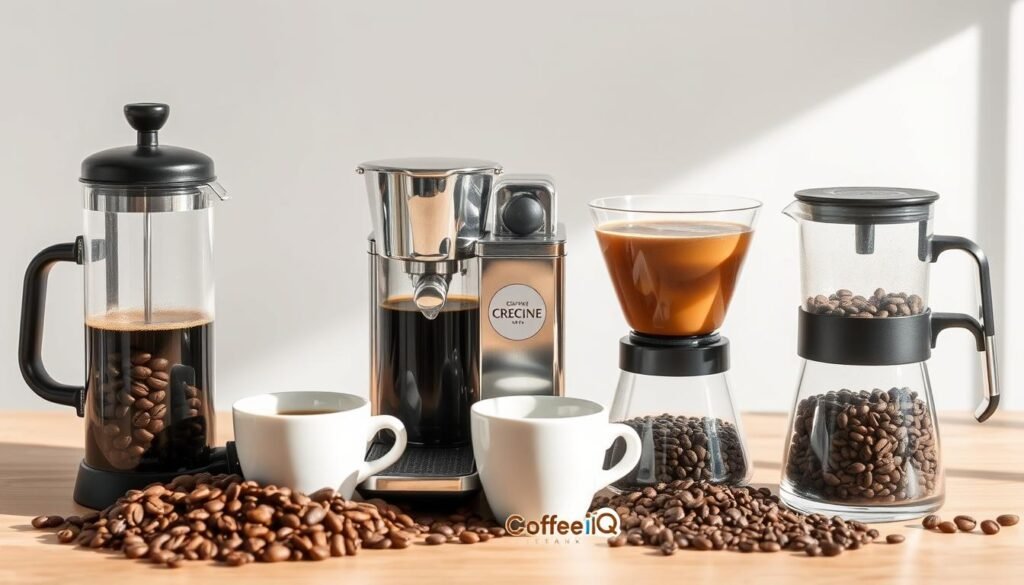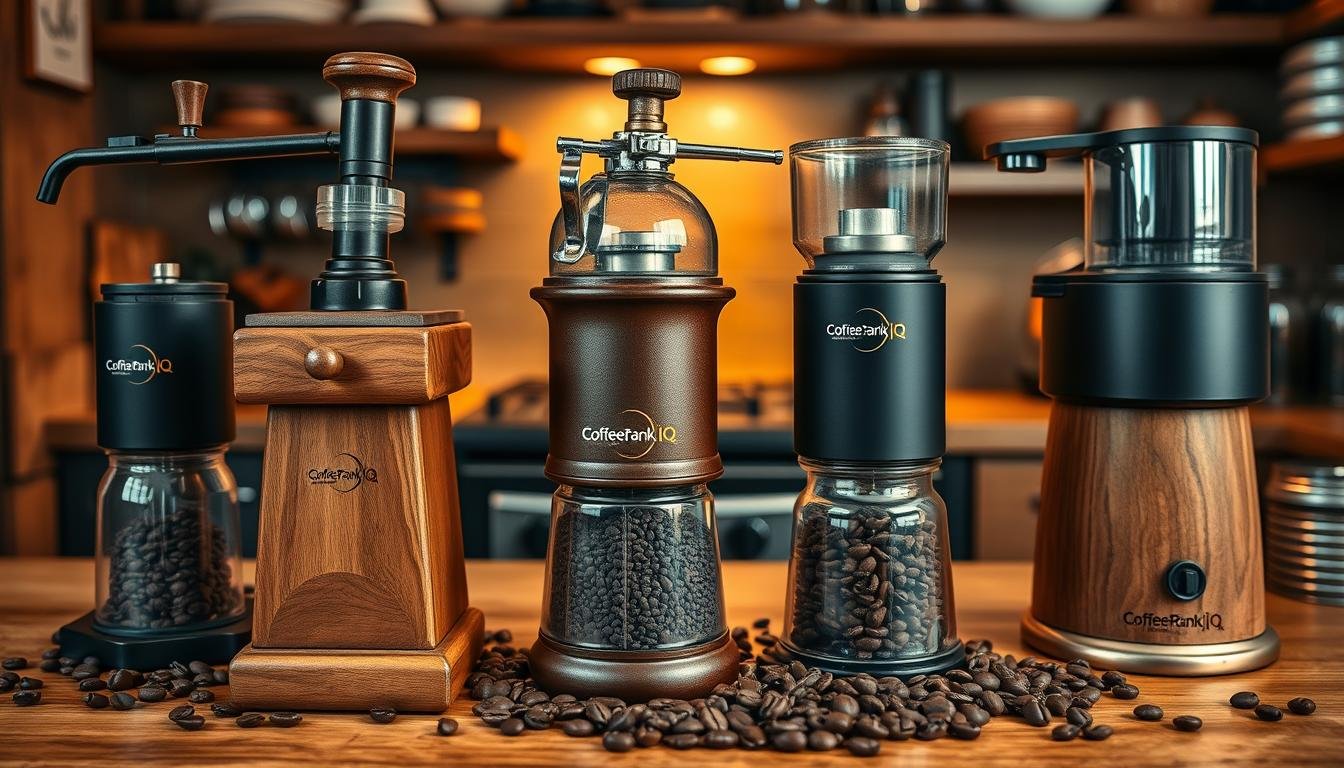Did you know that single-origin coffees account for a staggering 60% of total coffee sales? This surprising statistic highlights the growing demand for specialty coffee drinkers seeking unique flavor profiles and a deeper connection to the origin of their beans. As you navigate the world of coffee, the choice between single-origin and blended beans can have a significant impact on the taste and experience in your cup.
Coffee is a complex and nuanced beverage, and the decision between single-origin and blended coffee beans can profoundly influence the flavor profile of your brew. Single-origin coffees are sourced from a specific farm or region, offering a unique expression of terroir and highlighting the natural characteristics of the beans. On the other hand, coffee blends combine beans from different origins to create a harmonious and consistent flavor profile. Understanding the differences between these two approaches can help you choose the coffee beans that best suit your taste preferences and brewing methods.
Key Takeaways
- Single-origin coffees account for 60% of total coffee sales, reflecting the growing demand for unique flavor profiles.
- Single-origin coffees offer a more complex and nuanced flavor experience, while blends provide a consistent and balanced taste.
- The cost of sourcing single-origin or blended coffees from reputable roasters is indicative of the quality and care taken in the coffee’s production process.
- Personal preferences play a significant role in determining whether one prefers single-origin or blended coffees.
- Blending coffee is an art that requires expertise in roasting, cupping, and combining different coffee beans to achieve the perfect blend.
Understanding Single-Origin Coffee
Single-origin coffee refers to beans that come from a single farm, cooperative, or region. These coffees are prized for their ability to showcase the unique flavors and characteristics of a specific growing area, influenced by factors such as soil, elevation, and processing methods. Single-origin coffees often have a more complex and nuanced flavor profile, allowing coffee enthusiasts to explore the diversity of the coffee world.
What is Single-Origin Coffee?
Single-origin coffee is coffee that comes from a single source, such as a farm or a specific lot within that farm, and from a single harvest. This means the coffee beans are not blended with beans from other regions or farms, but rather they are the pure expression of a particular terroir and processing method.
Coffee Traceability and Transparency
Coffee traceability has become increasingly important in the specialty coffee industry, as it allows consumers to learn more about the origins and production methods of their coffee. Traceable coffee provides detailed information about the cultivators, processing techniques, and supply chain, promoting transparency and encouraging equitable and sustainable practices.
| Statistic | Value |
|---|---|
| Single-origin coffee comes from a single source, such as a farm or a specific lot within that farm and from a single harvest. | – |
| Coffee traceability includes precise information on where and how the coffee was cultivated and processed and how much every person involved was paid along the way. | – |
| Single-origin coffees are known for their uniqueness, showcasing the nuances of specific regions, varietals, and processing techniques to deliver complex and adventurous flavors. | – |
| The quality of single-origin coffee is reflected in the care taken by the farmer and the roaster, which can result in great flavors if the coffee has been properly cultivated and processed. | – |
By understanding the origins and production methods of single-origin coffee, consumers can make more informed choices and support sustainable and equitable coffee practices.
Understanding Coffee Blends
What are Coffee Blends?
Coffee blends are created by carefully combining beans from different origins to achieve a specific flavor profile. Skilled roasters and blenders select and proportion the individual components to craft a harmonious, balanced, and consistent cup of coffee. These blends are often used in commercial settings, such as cafes and coffee shops, to provide a predictable and reliable taste experience for customers.
Consistency and Flavor Profiles
One of the key advantages of coffee blends is their ability to maintain a consistent flavor profile over time. As the availability of individual coffee components may fluctuate due to seasonal changes or supply chain disruptions, blenders can adjust the blend recipe to ensure a stable and recognizable taste. This consistency is highly valued by coffee drinkers who seek a familiar and reliable experience with every cup.
Coffee blends are designed to deliver a balanced and complex flavor profile, often described as “full-bodied” and offering a range of intricate notes. This makes them suitable for a wide variety of coffee enthusiasts, catering to different preferences and brewing methods. In contrast, single-origin coffees are known for their distinct and sometimes more adventurous flavors, appealing to those seeking a unique tasting experience.
“A well-crafted coffee blend is like a symphony of flavors, where each component plays a crucial role in creating a harmonious and captivating experience.”
Ultimately, the choice between single-origin and blended coffees comes down to personal preference and the desired flavor profile. Whether you’re seeking a familiar and consistent taste or an adventurous tasting journey, the world of coffee offers a diverse range of options to explore and enjoy.
Single-Origin vs. Blends: Choosing the Right Coffee Beans for Your Taste
When it comes to selecting coffee beans, the choice between single-origin and blended varieties ultimately comes down to your personal taste preferences. Single-origin coffees offer a more transparent and nuanced flavor experience, allowing you to explore the unique characteristics of a specific region or processing method. Blends, on the other hand, provide a more consistent and balanced cup, often with a broader appeal.
As you navigate the world of coffee, consider factors such as your brewing method, desired flavor profile, and whether you prefer the complexity of a single origin or the reliability of a well-crafted blend. Single-origin coffees are lauded for their adventurous flavors and complexity, appealing to those seeking new taste experiences. Blends, on the other hand, are designed to offer flavor consistency, catering to consumers who prefer a uniform taste with every sip.
Ultimately, the right choice between single-origin and blended coffee beans comes down to your personal preference. Whether you’re drawn to the unique terroir-driven flavors of a single origin or the harmonious balance of a carefully curated blend, the key is to choose the coffee that best suits your taste buds and brewing style.
| Single-Origin Coffee | Coffee Blends |
|---|---|
| Offers a more transparent and nuanced flavor experience | Provides a more consistent and balanced cup |
| Showcases the unique characteristics of a specific region or processing method | Combines beans from multiple origins to create a unique taste profile |
| Appeals to those seeking new and adventurous flavors | Caters to consumers who prefer a uniform taste experience |
| Generally more expensive compared to blends | Generally cheaper than single-origin coffee |
| Lower availability in the market | Higher availability in the market |
As you explore the world of coffee, consider the factors that matter most to you, whether it’s the captivating complexity of a single origin or the reliable consistency of a well-crafted blend. The choice is yours, and it’s a journey worth savoring.
Exploring the Flavor Spectrum with Single Origins

For the true coffee connoisseur, single-origin coffees offer a gateway to a world of captivating flavors. These beans, grown and harvested from a single geographic location, showcase the unique terroir and processing methods that shape their distinct taste profiles. Whether you’re seeking bright, fruity notes or deep, earthy undertones, the exploration of single-origin offerings can be a thrilling journey of discovery.
Each single-origin coffee carries with it a story, a reflection of the care and expertise poured into its cultivation and roasting. A good single-origin coffee reflects the care taken by the farmer and roaster, preserving the unique flavors shaped by factors like elevation, rainfall, and sunlight exposure. By delving into the tasting notes of these exceptional beans, you can uncover a diverse spectrum of aromas and flavors, from the floral and citrusy characteristics of an Ethiopian Yirgacheffe to the rich, chocolaty notes of a Sumatran coffee.
“Single-origin coffee is sourced from a single geographic location, such as one country, region, or specific farm within a region. Single-origin coffee beans typically offer a unique flavor profile that represents the area where they are grown.”
As you navigate the world of single-origin coffees, you’ll find that each cup tells a captivating story, a reflection of the land, the people, and the processes that shaped its creation. By embracing this diversity, you’ll not only expand your palate but also deepen your appreciation for the art of coffee cultivation and roasting.
Whether you’re a seasoned coffee enthusiast or just embarking on your journey, exploring the flavor spectrum of single-origin coffees can be a truly rewarding experience. Savor the nuances, uncover the hidden gems, and let your taste buds be guided on an adventure through the vibrant world of single-origin coffee.
The Art of Coffee Blending
Crafting the perfect coffee blend is an intricate art form that requires meticulous attention to detail. Coffee blenders must skillfully balance the body, acidity, and flavor profiles of individual coffee beans to create a harmonious and captivating drinking experience. By carefully selecting and combining complementary coffee origins, blenders can unlock a symphony of complex and well-rounded flavors.
Balancing Body, Acidity, and Flavor
The art of coffee blending involves a delicate dance between the diverse characteristics of various coffee beans. Blenders must meticulously experiment, cup, and adjust their formulas to ensure the final blend meets the desired flavor profile. Through this process, they can create a blend that offers a cohesive and deeply satisfying taste, with each component complementing the others to form a harmonious whole.
For instance, a blend might feature a full-bodied coffee to provide a robust backbone, balanced by a brighter, more acidic coffee to lend a refreshing, fruity note. The blender’s expertise lies in finding the perfect ratio to achieve a balanced, complex flavor that tantalizes the palate.
“The art of blending coffee is all about creating a harmonious symphony of flavors, where each note complements the others to form a truly captivating experience.”
Whether crafting a blend for a specialty café or a personal coffee routine, the art of coffee blending requires a deep understanding of the unique flavor profiles of various coffee origins. By mastering this craft, blenders can unlock a world of coffee bliss, offering consumers a chance to explore the boundless possibilities of this beloved beverage.
Brewing Methods for Single Origins and Blends

The brewing method can have a significant impact on the taste of both single-origin and blended coffees. For single-origin coffees, the pour over method is often recommended, as it allows the unique flavors and nuances of the beans to shine. The pour over technique’s gentle extraction process helps to preserve the delicate characteristics of single-origin coffees.
In contrast, blended coffees may perform better in espresso-based drinks, where the high-pressure extraction can integrate the various components and create a balanced, full-bodied cup. Coffee blends are often specifically designed for use in espresso-based drinks, such as lattes and cappuccinos. The balanced and consistent flavor profiles of these blends can stand up well to the addition of milk, creating a harmonious and enjoyable drink.
The complexity of single-origin coffees, while delightful on their own, may be overpowered or obscured when combined with milk, making blends a more suitable choice for milk-based beverages.
Pour Over Brewing for Single Origins
The pour over method allows the unique flavors and subtle nuances of single-origin coffees to be fully expressed. This gentle brewing technique extracts the beans’ delicate characteristics, showcasing the coffee’s true potential.
Espresso Blends and Milk-Based Drinks
Coffee blends are often formulated to perform exceptionally well in espresso-based drinks, such as lattes and cappuccinos. The balanced and consistent flavor profiles of these blends can stand up to the addition of milk, creating a harmonious and enjoyable experience.
“The complexity of single-origin coffees, while delightful on their own, may be overpowered or obscured when combined with milk, making blends a more suitable choice for milk-based beverages.”
History and Evolution of Coffee Blends
The history of coffee blends dates back centuries, with the earliest known blend being the Mocha-Java. This iconic combination brought together a bright coffee from Yemen with a heavy, chocolaty coffee from Java, creating a harmonious flavor profile that captivated coffee enthusiasts. As coffee cultivation and trade expanded globally, the practice of blending coffees to achieve distinctive taste characteristics became more widespread.
In the 20th century, the rise of espresso culture saw the emergence of espresso blends. These innovative combinations united lower-quality Robusta beans with higher-quality Arabica beans, leveraging the high-pressure extraction process to deliver a satisfying and consistent cup of coffee. The evolution of coffee blends continued, with modern roasters carefully curating unique blends to meet the evolving preferences and palates of discerning coffee drinkers.
Today, coffee blends have become an integral part of the specialty coffee landscape, allowing roasters to showcase their expertise and creativity. By skillfully balancing the nuances of various coffee origins, roasters can craft blends that offer a diverse range of flavor profiles, from bright and fruity to rich and chocolaty. This artistry not only satisfies the preferences of coffee connoisseurs but also introduces newcomers to the depth and complexity of the coffee world.
| Coffee Blend | Origin | Flavor Profile |
|---|---|---|
| Mocha-Java | Yemen and Java | Bright, chocolaty |
| Espresso Blend | Robusta and Arabica | Smooth, balanced |
| House Blend | Multiple Origins | Versatile, well-rounded |
The evolution of coffee blends is a testament to the ingenuity and passion of the coffee industry. By blending coffee from diverse origins, roasters continue to push the boundaries of flavor, creating unique and captivating experiences for coffee enthusiasts worldwide.
“The art of blending coffee is to create a harmonious balance of flavors, where the whole is greater than the sum of its parts.”
Conclusion
In the captivating world of specialty coffee, the choice between single-origin and blended beans reflects your unique taste preferences and brewing methods. Single-origin coffees offer a remarkable opportunity to explore the nuances of terroir and processing, providing a complex and distinctive flavor profile. Conversely, coffee blends deliver a consistent and well-balanced taste, particularly complementing milk-based drinks like lattes and flat whites.
By understanding the differences between these two approaches, you can make an informed decision about the beans that best suit your taste buds and brewing preferences. Whether you prefer the complexity of a single origin or the reliability of a carefully crafted blend, the world of coffee presents a vast and captivating landscape for you to discover.
Ultimately, the decision between single-origin and blends comes down to your personal taste and the coffee experience you seek. By exploring the diverse flavor spectrum and experimenting with various brewing methods, you can uncover the coffee that truly resonates with your palate and elevates your daily ritual. Embrace the journey of discovering your perfect coffee, and savor the joy of each sip.
FAQ
What is the difference between single-origin and blended coffee beans?
Single-origin coffees are sourced from a specific farm or region, offering a unique expression of terroir and highlighting the natural characteristics of the beans. Coffee blends, on the other hand, combine beans from different origins to create a harmonious and consistent flavor profile.
What are the benefits of single-origin coffees?
Single-origin coffees are prized for their ability to showcase the unique flavors and characteristics of a specific growing area, influenced by factors such as soil, elevation, and processing methods. They often have a more complex and nuanced flavor profile, allowing coffee enthusiasts to explore the diversity of the coffee world.
What are the advantages of coffee blends?
Coffee blends provide a consistent and balanced cup, often with a broader appeal. Blenders carefully select and proportion the individual components to create a harmonious flavor profile, which is particularly useful in commercial settings like cafes and coffee shops.
How do brewing methods affect the taste of single-origin and blended coffees?
The pour over method is often recommended for single-origin coffees, as it allows the unique flavors and nuances of the beans to shine. In contrast, blended coffees may perform better in espresso-based drinks, where the high-pressure extraction can integrate the various components and create a balanced, full-bodied cup.
What is the history and evolution of coffee blends?
The earliest known coffee blend is the Mocha-Java, which combined a bright coffee from Yemen with a heavy, chocolaty coffee from Java. As coffee cultivation and trade expanded globally, the practice of blending coffees to create distinctive flavor profiles became more widespread. In the 20th century, espresso blends emerged as a way to combine lower-quality Robusta beans with better-quality Arabica beans.




